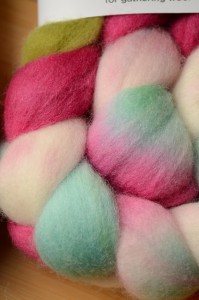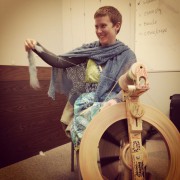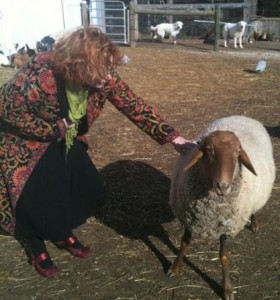A Wool Lover’s Visit to the North of England
The trip I went on in May with Rowan Tree Travel to southwestern England was so wonderful that I had to go again on a similar trip in northern England at the end of September.
The trip I went on in May with Rowan Tree Travel to southwestern England was so wonderful that I had to go again on a similar trip in northern England at the end of September.
Are you “up to your neck” in a project or in stash? Perhaps you’re concentrating instead, and you’ve hunched up your shoulders practically to your ears. That experienced spinner at the guild meeting, she stands “head and shoulders” above the rest.
We all find comfort in the flow of fibre through our hands and the gentle rhythm of treadling and drafting. And it turns out it’s all because spinning does good things to our brains.
Much has been written about finding time for ourselves. Especially during the COVID-19 lockdown in the United States, I saw many articles discussing the ways in which one can take advantage of the downtime. “Learn a new hobby!” many suggested. “Read these books this week!” I saw, too. Back when we thought the pandemic would last a whopping two weeks, we saw people find new ways of spending their time.
For the most part I can take critique. I can. In my 20s I was terrible at taking it but somewhere in my 30s I gained an appreciation for good critique — people telling me things that could make whatever it is I’m doing, better. For many people, and for me up until recently, critique usually comes from just a select few – a friend reading your article, a partner going over a story, a kid giving feedback on how exactly you could make dinner edible. But that’s changed. When you publish something like a magazine, your critiques come from all over, all the time.
And I should be okay with that. But since I’m also a person that likes to please everyone, getting feedback from dozens, hundreds, thousands of spinners can be a bit tough on the brain, you know? It’s impossible to please all those people but what about when your brain constantly tries?
I’m not complaining or whining. Really, I’m not. I’m looking for advice on how to deal with this internally, in my own head. I intellectually realize that I can’t possibly make every spinner happy. I totally realize that. But sometimes my brain is sneaky, uncontrolled, and it still wants to. And so when I get emails from spinners that think the print is too big, or too small, or that there should be less photos and more content, or that they’d like to see more big photos, or that there’s not enough weaving/crochet/knitting, or that they like the themed issues but only if they are interested in the theme, or that they’d like more advanced and technical articles, or that they’d like more beginner articles, or that they’d like it to be cheaper (I can’t fix that one without adding more ads), or that they’d like their mail carrier to deliver it quicker, or a hundred other things that I get emails about, my brain obsesses a bit.
Okay, who am I kidding? It obsesses a lot. I know it’s not rational. I do. But I can’t help it. I write and rewrite a response to them in my head for hours, sometimes all day. I can’t get past it. Some of my responses want to give them what they want, some are defensive, some explain in way more detail than anyone would want why I just can’t do it, or how it’s a delicate balance, or how on and on in my head.
I’m not looking for anyone to say that they shouldn’t write me, I’m glad that people do write, I actually value every email I get (except the very mean ones, but those only come in occasionally, twice a month or so), I’m just trying to figure out how to deal with it all.
Anyone have any ideas? Anyone have to deal with this kind of thing – being a people pleaser and hearing from lots and lots of people the various (and contradicting) ways to please them?
Jillian told me before I started the magazine that it would break my heart. It hasn’t broken my heart yet but it’s threatening to break my head! Actual advice very much appreciated!
Last week Jillian spoke beautifully about rejection. She said it all perfectly. I agree with every feeling.
Today I thought I’d talk about my process of writing an article after the joyous news comes that my article idea has been accepted. This is the way I go about things and I happen to know that Jillian’s process is completely different than mine so ask her to tell you how she works.
OK, so when I submit an article idea for consideration I have an idea about how the yarns will look if I use a certain spinning method and I often want to talk about the technical details about how to get to the final yarn. That’s usually all I know and more often than not, I don’t have samples to back my words up.
When I write I need to have the yarn and swatches sitting right next to me so I can feel them in my hands. If I get stuck I pick up the samples and sniff them, hug them, feel them, rub them, anything that will get a littel spark going.
What that means is that all or most of my samples need to be spun before I start writing. What that also means is that I need to have a pretty good idea of what I want to show. I’m not great at writing detailed outlines. So for articles I usually just have a short paragraph that I’ve written to give me some idea of where I’m heading and then I choose fibers and spinning techniques that will get me there.
For example, the article in the Leicesters issue, I knew that I was limited to the three Leicesters and my article was about spinning for softness. Of course I wanted to choose the most coarse Leicester to demonstrate what I do so English Leicester was the choice (aka Leicester Longwool, or Dishley Leicester)
After I choose the fiber then I choose the wheel that will do what I want most easily. Often that is my Schacht Matchless. I can treadle pretty slowly and count treadles or whatever I have to do to make the yarn exactly what I want on that wheel. My other wheels have much larger drivewheels and I usually choose one of them when I want to get the work done fast and I don’t have to slow down so I can describe the process later.
This was actually the same process I used for writing my book. I had an outline which really was just a list of chapters. I wrote the breeds I wanted to use for each chapter under each heading and started spinning. Spinning for that project took about 6 months with 6 months of writing following the spinning. But having all of the samples right near me for inspiration was the greates thting I could have done for myself.
Right now I’m almost finished writing an article for the Singles Issue of Ply that’s coming up. It’s due in 5 days. I think I can make it because I have my samples.

A little Sheepspot
I get rejected a lot. I propose a lot of classes and articles all over the place and most of the time the answer is no. Even when I get asked to propose, frequently I get a no.
I used to wallow in the gross feeling of not getting picked, but now I don’t.
It’s not instantly sunshine and lollypops, I take my moment to relive not getting picked for dodgeball in 5th grade, then move on. It’s part of the process.
Then I’m back at the work of ideas and proposals. Here’s a not so secret, secret, the stuff that gets rejected will get accepted. It may become a small part of something else, it might get combined with two or three other things, it might get accepted, as is, somewhere else. Any thinking or planning is good work.

A little Fiberstory
This week I got rejected by PLY. I sent in an article proposal awhile back and this week I got a nice form email from Jacey saying basically, thanks, but no thanks.
Guess what? I’m happy about it.
Now don’t get me wrong, I had a minute or two of that cruddy rejection feeling, but quickly thought differently. It’s not about my idea’s worth or even my personal worth, it’s about the magazine, and that made me happy.
What quickly pushed any gloomy thoughts out of my brain was the thought of getting that finished magazine in my inbox and seeing how it was built into a great issue. How the articles and projects balance each other and the idea of the theme. I know I’ll see instantly that my idea would have been OK, but wasn’t quite right.
Jacey has proved herself again and again that she knows how to make an excellent issue of our excellent magazine. When I get to be part of the inside I am overjoyed. When I get to participate as a reader I am completely content to roll around in other people’s ideas and learn a bunch about spinning.

Fiberstory, fat
And that rejected idea? I’m already using it somewhere else!
I’m in New Mexico. I’m not supposed to be here, but here I am. I had a fantastic weekend with the Las Aranas guild, spinning and braving the snow and ice covered roads (in New Mexico!). While I was here I received the most amazing indigo-dyed gossamer shawl I’ve ever had the luck to fold in half and drape around my shoulders. Knit by mara bishop statnekov, I can’t take it off. Ever. As kind as it is beautiful.
I was supposed to be home early this morning. I was supposed to leave tomorrow morning for Iceland, with a 3 hour layover in Denver. Instead, and due to the ice here in NM and in TX, I’m meeting Levi and O (my 8-year old daughter) in Denver tomorrow and then off to Iceland. It’s all going to be fine. It is. I know it.

And Iceland is going to be fantastic. I can hardly wait. I’m teaching for 2 days, giving a talk at the art school, and touring for 5 days. While I’m there, the Leicester issue will be winging it’s way to you. You’re going to love it, I think. I love it. I know I always say that, but I do.
But while I’m captured by ice in New Mexico, I’d like to talk about something.
Years ago, I used to hear a few people grumble with frustration that they’d propose article ideas to Spin Off and then later they’d see their article idea in the magazine but written by somebody else. They would say that it wasn’t fair or nice that the magazine would take their proposal and get somebody else to write it. Of course, I thought that wasn’t fair or nice too. Who wouldn’t? It’s only now that I realize that was probably not at all what was really happening.
I say this because I have some personal experience with this very thing. Every issue I get (thankfully) lots and lots of proposals. Sometimes over 200. It’s wonderful and the reason the magazine is so great. However, out of those 200 proposals, there might be 100 that are actually different. What I mean is that the same general proposal will come in from 5 or 6 people. It won’t be exact, of course, but it’ll be the same in spirit. And so if it’s an article that enriches the issue, that makes it big and round and awesome, I’ll ask one of the authors that proposed it, to write it.
What that means is that several other people will later see the article in the magazine. It will look like the article they proposed, and it is, but it’s also the article the author of the article proposed.
Spinning is an old craft. Spinners are brilliant. It makes sense that several of us come up with the same ideas about a particular topic, right?
So, just in case you were wondering, and because I hate the idea of people going around feeling sad, or thinking that we don’t like them, or even that we’re not nice or fair, let me assure you, we don’t ever take one person’s idea and ask another person to write it. Not ever. I’m pretty sure that Spin Off doesn’t do it either.
I love Thanksgiving. I love that it’s the beginning of the Holiday season. So many people celebrate so many things during this part of the year and it’s all great fun. I love that my family gets together most years – except for my one very far away sister who we always miss. I love all the food and I love that I can pretend that I am not constantly concerned about what I’m eating. I love that I can start decorating for Christmas and I love that my mom has taught me how to do it right. (She has 12 trees in her house this year) Here are the three I could see while standing in one spot.

Anyway, just like many of you, I start to think about all the things I’m thankful for and this year I am thankful for my job. I’m thankful that I’m in a position that I can pursue this crazy life. I mean, for what other career could I dress up and go pet a sheep?

And I’m thankful for the friends that I’ve made while working. I’ll just name 2 here but there are so many others.
 Jacey Boggs! Fantastic teacher, wonderful writer and owner of this magazine that I love so much.
Jacey Boggs! Fantastic teacher, wonderful writer and owner of this magazine that I love so much.
And Jillian Moreno who is also an extraordinary teacher, the kind of writer that makes you laugh and learn at the same time and a person who always is pushing me to be better.
Aren’t they pretty?
Ask me about all the other ones too. I could go on and on. But right now I need to go eat some pie.
This site uses cookies. By continuing to browse the site, you are agreeing to our use of cookies.
OKLearn moreWe may request cookies to be set on your device. We use cookies to let us know when you visit our websites, how you interact with us, to enrich your user experience, and to customize your relationship with our website.
Click on the different category headings to find out more. You can also change some of your preferences. Note that blocking some types of cookies may impact your experience on our websites and the services we are able to offer.
These cookies are strictly necessary to provide you with services available through our website and to use some of its features.
Because these cookies are strictly necessary to deliver the website, refusing them will have impact how our site functions. You always can block or delete cookies by changing your browser settings and force blocking all cookies on this website. But this will always prompt you to accept/refuse cookies when revisiting our site.
We fully respect if you want to refuse cookies but to avoid asking you again and again kindly allow us to store a cookie for that. You are free to opt out any time or opt in for other cookies to get a better experience. If you refuse cookies we will remove all set cookies in our domain.
We provide you with a list of stored cookies on your computer in our domain so you can check what we stored. Due to security reasons we are not able to show or modify cookies from other domains. You can check these in your browser security settings.
These cookies collect information that is used either in aggregate form to help us understand how our website is being used or how effective our marketing campaigns are, or to help us customize our website and application for you in order to enhance your experience.
If you do not want that we track your visit to our site you can disable tracking in your browser here:
We also use different external services like Google Webfonts, Google Maps, and external Video providers. Since these providers may collect personal data like your IP address we allow you to block them here. Please be aware that this might heavily reduce the functionality and appearance of our site. Changes will take effect once you reload the page.
Google Webfont Settings:
Google Map Settings:
Google reCaptcha Settings:
Vimeo and Youtube video embeds:
The following cookies are also needed - You can choose if you want to allow them:
